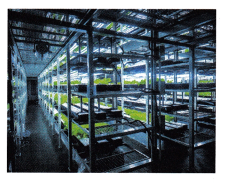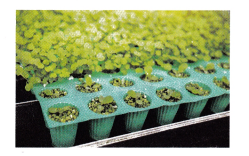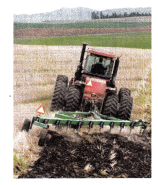We included HMH Into Math Grade 4 Answer Key PDF Module 16 Lesson 4 Solve Problems Using Multiplication of a Fraction or Mixed Number by a Whole Number to make students experts in learning maths.
HMH Into Math Grade 4 Module 16 Lesson 4 Answer Key Solve Problems Using Multiplication of a Fraction or Mixed Number by a Whole Number
I Can solve problems involving the multiplication of mixed numbers and whole numbers.
Step It Out
Question 1.
Armando is a plant biologist who works at an urban indoor vertical farm. He adds 1\(\frac{1}{4}\) gallons of plant food to each of 3 arugula trays. How much plant food does he use?

A. Write 1\(\frac{1}{4}\) as a fraction greater than 1.
Answer:
\(\frac{5}{4}\)
Explanation:
When the numerator of the fraction is greater than the denominator, it is a fraction greater than 1.
1\(\frac{1}{4}\) = \(\frac{5}{4}\)
B. Write a multiplication equation representing the product of the whole number and the fraction greater than 1.
Answer:
\(\frac{15}{4}\)
Explanation:
When the numerator of the fraction is greater than the denominator, it is a fraction greater than 1.
1\(\frac{1}{4}\) = 3 x \(\frac{5}{4}\) = \(\frac{15}{4}\)
C. Write the product as a mixed number.
Answer:
3 x \(\frac{5}{4}\)
Explanation:
1\(\frac{1}{4}\) = \(\frac{5}{4}\)
= 3 x \(\frac{5}{4}\) = \(\frac{15}{4}\)
D. How much plant food does Armando use?
Answer:
\(\frac{15}{4}\)
Explanation:
Armando adds 1\(\frac{1}{4}\) gallons of plant food to each of 3 arugula trays.
Total plant food he use = 3 x \(\frac{5}{4}\) = \(\frac{15}{4}\)
Turn and Talk How could you use the Distributive Property to find the product using mental math?
Answer:
Distributive property means multiplying the sum of two or more addends by a number will give the same result. So, multiplying each addend individually by the number and then adding the products together.
Explanation:
8 x 34 = 272
8 ( 30 + 4) = 240 + 32 = 272
Question 2.
Each tray of herbs at the vertical farm uses 2\(\frac{3}{4}\) packets of seeds. How many packets are needed for 6 trays?

A. Rename 2\(\frac{3}{4}\) as a fraction greater than 1.
Answer:
\(\frac{11}{4}\)
Explanation:
When the numerator of the fraction is greater than the denominator, it is a fraction greater than 1.
2\(\frac{3}{4}\) = \(\frac{11}{4}\)
B. Write an equation to model the product of the whole number and the fraction greater than 1 and then solve it. Let p represent the number of packets needed.
Answer:
16 \(\frac{1}{2}\) packets needed.
Explanation:
P = 2\(\frac{3}{4}\)
p = \(\frac{11}{4}\)
number of packets needed = 6 x \(\frac{11}{4}\)
= \(\frac{66}{4}\) = 16\(\frac{1}{2}\)
C. Rename the product as a mixed number.
Answer:
16 \(\frac{1}{2}\)
Explanation:
for 1 tray = 2\(\frac{3}{4}\) = \(\frac{11}{4}\)
For 6 trays = 6 x \(\frac{11}{4}\)
= \(\frac{66}{4}\) = 16\(\frac{1}{2}\)
D. How many packets are needed for 6 trays?
Answer:
16\(\frac{1}{2}\)
Explanation:
for 1 tray = 2\(\frac{3}{4}\) = \(\frac{11}{4}\)
for 6 trays = 6 x \(\frac{11}{4}\)
= \(\frac{66}{4}\) = 16\(\frac{1}{2}\)
Turn and Talk How could you find the product of this problem without renaming 2\(\frac{3}{4}\) as a fraction greater than 1?
Answer:
\(\frac{11}{4}\)
Explanation:
Convert the mixed fraction into improper fraction.
2\(\frac{3}{4}\) = \(\frac{11}{4}\)
Check Understanding
Question 1.
Tammi uses 2\(\frac{2}{3}\) gallons of water on her plants once a week. How much water does she use in 3 weeks?
Answer:
8 gallons
Explanation:
Tammi uses 2\(\frac{2}{3}\) gallons of water on her plants once a week.
Total gallons of water she use in 3 weeks,
2\(\frac{2}{3}\) = \(\frac{8}{3}\)
3 x \(\frac{8}{3}\) = \(\frac{24}{3}\) = 8 gallons
Question 2.
At an urban vertical farm, each tray of arugula makes about 3\(\frac{5}{8}\) pounds of edible plants. How many pounds will 5 trays make?
Answer:
18\(\frac{1}{8}\)
Explanation:
Each tray of arugula makes about 3\(\frac{5}{8}\) pounds of edible plants.
5 trays will make = 5 x 3\(\frac{5}{8}\)
= 5 x \(\frac{29}{8}\) = \(\frac{145}{8}\)
= 18\(\frac{1}{8}\)
Find the product.
Question 3.
5 × 3\(\frac{4}{5}\) = __________
Answer:
\(\frac{95}{5}\) = 19
Explanation:
5 x 3\(\frac{4}{5}\) = 5 x \(\frac{19}{5}\)
= \(\frac{95}{5}\) = 19
Question 4.
4 × 3\(\frac{2}{3}\) = ___________
Answer:
\(\frac{44}{3}\)
Explanation:
4 x 3\(\frac{2}{3}\) = 4 x \(\frac{11}{3}\)
= \(\frac{44}{3}\)
On Your Own
Question 5.
Model with Mathematics Mr. Dayton uses 3\(\frac{3}{8}\) gallons of diesel fuel in his tractor each time he plows one of his four 50-acre fields. If he plows 4 fields, how much diesel fuel does he use? Model the problem with an equation, and then solve it.

Answer:
13\(\frac{4}{8}\) = 13.5gallon
Explanation:
Dayton uses 3\(\frac{3}{8}\) gallons of diesel fuel in his tractor each time 50-acre field.
If he plows 4 fields, how much diesel fuel does he use = 4 x 3\(\frac{3}{8}\)
= 4 x \(\frac{27}{8}\) = \(\frac{27×4}{8}\)
= \(\frac{108}{8}\) = 13\(\frac{4}{8}\) = 13.5gallon
Question 6.
Use Structure Ms. Abad purchases 7 packages of prewashed spinach to make a large salad for a school potluck dinner. Each package contains 1\(\frac{1}{4}\) pounds of spinach. How many pounds of spinach does Ms. Abad purchase?
Answer:
8\(\frac{3}{4}\) pounds
Explanation:
Ms. Abad purchases 7 packages of prewashed spinach to make a large salad for a school potluck dinner.
Each package contains 1\(\frac{1}{4}\) pounds of spinach.
Total pounds of spinach Ms. Abad purchase = 7 x 1\(\frac{1}{4}\)
= 7 x \(\frac{5}{4}\) = \(\frac{35}{4}\) = 8\(\frac{3}{4}\)
Question 7.
Use Repeated Reasoning Lanny is planting radishes in 4 garden plots.. He uses 8\(\frac{2}{5}\) ounces of radish seeds in each plot. How many ounces of seeds does he use?
Answer:
33\(\frac{3}{5}\) ounces
Explanation:
Lanny is planting radishes in 4 garden plots.
He uses 8\(\frac{2}{5}\) ounces of radish seeds in each plot.
Total ounces of seeds he use = 4 x 8\(\frac{2}{5}\)
= 4 x \(\frac{42}{5}\) = \(\frac{42×4}{5}\)
= \(\frac{168}{5}\) = 33\(\frac{3}{5}\)
Question 8.
Critique Reasoning Darrin says he can find 4 × 3\(\frac{2}{5}\) by finding (4 × 3) + (4 × \(\frac{2}{5}\)). Is Darrin correct? Explain.
Answer:
Darrin is wrong.
Explanation:
4 × 3\(\frac{2}{5}\) = (4 × 3) + (4 × \(\frac{2}{5}\)).
4 × \(\frac{17}{5}\) = (12) + (\(\frac{22}{5}\)).
\(\frac{17×4}{5}\) = (12×5) + (\(\frac{22}{5}\)).
\(\frac{68}{5}\) = \(\frac{60+22}{5}\)
\(\frac{68}{5}\) = \(\frac{82}{5}\)
Find the product. If possible, write your answer as a mixed number.
Question 9.
4 × 3\(\frac{5}{6}\) = ___________
Answer:
15\(\frac{2}{6}\)
Explanation:
4 × 3\(\frac{5}{6}\) = 4 x \(\frac{23}{6}\)
\(\frac{92}{6}\) = 15\(\frac{2}{6}\)
Question 10.
10 × 2\(\frac{3}{4}\) = ___________
Answer:
27\(\frac{2}{4}\) = 27.5
Explanation:
10 × 2\(\frac{3}{4}\) = 10 x \(\frac{11}{4}\)
\(\frac{110}{4}\) = 27\(\frac{2}{4}\)
Question 11.
8 × 5\(\frac{2}{3}\) = ___________
Answer:
45\(\frac{1}{3}\)
Explanation:
8 × 5\(\frac{2}{3}\) = 8 x \(\frac{17}{3}\)
\(\frac{136}{3}\) = 45\(\frac{1}{3}\)
Question 12.
2 × 2\(\frac{7}{12}\) = ___________
Answer:
5\(\frac{2}{12}\)
Explanation:
2 × 2\(\frac{7}{12}\) = 2 x \(\frac{31}{12}\)
\(\frac{62}{12}\) = 5\(\frac{2}{12}\)
Question 13.
4 × 2\(\frac{4}{5}\) = ___________
Answer:
11\(\frac{1}{5}\)
Explanation:
4 × 2\(\frac{4}{5}\) = 4 x \(\frac{14}{5}\)
\(\frac{56}{5}\) = 11\(\frac{1}{5}\)
Question 14.
3 × 3\(\frac{3}{8}\) = ___________
Answer:
10\(\frac{1}{8}\)
Explanation:
3 × 3\(\frac{3}{8}\) = 3 x \(\frac{27}{8}\)
\(\frac{81}{8}\) = 10\(\frac{1}{8}\)
Question 15.
Reason David takes care of two horses. One horse eats 1\(\frac{1}{4}\) bags of oats each week. The other horse eats 11 bags of oats each week. How many bags of oats does David feed the two horses over 7 weeks?
Answer:
96\(\frac{1}{4}\)
Explanation:
One horse eats 1\(\frac{1}{4}\) bags of oats each week.
The other horse eats 11 bags of oats each week.
Total bags of oats David feed the two horses over 1 week = 11 x 1\(\frac{1}{4}\)
= 11 x \(\frac{5}{4}\) = \(\frac{55}{4}\) = 13\(\frac{3}{4}\) bags
Total bags of oats David feed the two horses over 7 weeks = 7 x 13\(\frac{3}{4}\)
7 x \(\frac{55}{4}\) = \(\frac{385}{4}\) = 96\(\frac{1}{4}\)
Question 16.
Use Structure Langston has 8 packets of corn seeds that he wants to plant in a community garden. Each packet contains 2\(\frac{2}{3}\) ounces of seeds. How many ounces of seeds does he have?
Answer:
21\(\frac{1}{3}\) ounces
Explanation:
Langston has 8 packets of corn seeds.
Each packet contains 2\(\frac{2}{3}\) ounces of seeds.
Total ounces of seeds he have in all = 8 x 2\(\frac{2}{3}\)
= 8 x \(\frac{8}{3}\) = \(\frac{64}{3}\) = 21\(\frac{1}{3}\)
Question 17.
Model with Mathematics A recipe for 1 loaf of bread calls for 1\(\frac{1}{4}\) cups of milk. Wade wants to make 4 loaves. How much milk does he need? Model the problem with an equation and then solve it. Let c represent the amount of milk he needs for 4 loaves.
Answer:
5 cups of milk
Explanation:
A recipe for 1 loaf of bread calls for 1\(\frac{1}{4}\) cups of milk.
Wade wants to make 4 loaves.
Total milk he need for 4 loaves = 4 x 1\(\frac{1}{4}\)
= 4 x \(\frac{5}{4}\) = \(\frac{20}{4}\) = 5 cups
Question 18.
Gordon is building a wooden table. Each leg is 3\(\frac{3}{8}\) feet long. What length of wood does he need for 4 legs?
Answer:
13\(\frac{4}{8}\) or 13 .5 feet long
Explanation:
Each leg is 3\(\frac{3}{8}\) feet long.
length of wood he need for 4 legs = 4 x 3\(\frac{3}{8}\)
= 4 x \(\frac{27}{8}\) = \(\frac{108}{8}\)
= 13\(\frac{4}{8}\) = 13 .5 feet long
Find the product. If possible, write your answer as a mixed number.
Question 19.
3 × 2\(\frac{5}{6}\) = ___________
Answer:
8\(\frac{3}{6}\)
Explanation:
3 x 2\(\frac{5}{6}\) = 3 x \(\frac{17}{6}\)
= \(\frac{51}{6}\) = 8\(\frac{3}{6}\)
Question 20.
4 × 4\(\frac{3}{10}\) = ___________
Answer:
17\(\frac{2}{10}\)
Explanation:
4 x 4\(\frac{3}{10}\) = 4 x \(\frac{43}{10}\)
= \(\frac{172}{10}\) = 17\(\frac{2}{10}\)
Question 21.
6 × 2\(\frac{9}{10}\) = ___________
Answer:
17\(\frac{4}{10}\)
Explanation:
6 x 2\(\frac{9}{10}\) = 6 x \(\frac{29}{10}\)
= \(\frac{174}{10}\) = 17\(\frac{4}{10}\)
Question 22.
2 × 3\(\frac{3}{6}\) = ___________
Answer:
\(\frac{42}{6}\) = 8
Explanation:
2 x 3\(\frac{3}{6}\) = 2 x \(\frac{21}{6}\)
= \(\frac{42}{6}\) = 8
Question 23.
7 × 2\(\frac{3}{4}\) = ___________
Answer:
19\(\frac{1}{4}\)
Explanation:
7 x 2\(\frac{3}{4}\) = 7 x \(\frac{11}{4}\)
= \(\frac{77}{4}\) = 19\(\frac{1}{4}\)
Question 24.
9 × 2\(\frac{2}{3}\) = ___________
Answer:
\(\frac{72}{3}\) = 24
Explanation:
9 x 2\(\frac{2}{3}\) = 9 x \(\frac{8}{3}\)
= \(\frac{72}{3}\) = 24